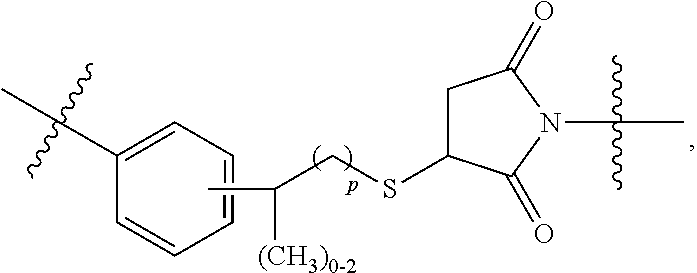Terminally modified polymers and conjugates thereof
a technology of polymers and conjugates, applied in the field ofterminally modified polymers and conjugates thereof, can solve the problems of increasing the number and complexity of forms, reducing the potency and therapeutic effects of many drugs, and increasing the difficulty of drug development and application
- Summary
- Abstract
- Description
- Claims
- Application Information
AI Technical Summary
Benefits of technology
Problems solved by technology
Method used
Image
Examples
example 1
tion
[0774]
Procedure A
[0775]To a solution of 50 kDa PHF (10.0 g, 74.6 mmol) in water (100 g) at 5-10° C. was added an aqueous solution of sodium (meta) per iodate (NaIO4, 1.28 g, 6.0 mmol) in water (10 g) over a period of 15 minutes and the resulting mixture was then stirred for 16 hours at room temperature. The reaction mixture was cooled to 5-10° C. and pH was adjusted to 6.5. The solution was purified by diafiltration using a 5 kDa MWCO Biomax membrane filter, followed by lyophilization to give the desired product; 8.9 g, 89% yield. 1H-NMR showed the appearance of signals at ˜8.2 ppm.
Procedure B
[0776]To a solution of 50 kDa PHF (15.0 g, 112 mmol) in water (150 g) at 5-10° C. was added an aqueous solution of sodium (meta) per iodate (NaIO4, 2.0 g, 9.4 mmol) in water (20 g) over a period of 15 minutes and the resulting mixture was then stirred for 16 hours at 5-15° C. The pH was adjusted to 6.5. The resulting solution was purified by SEC followed by diafiltration using a 5 kDa MWCO ...
example 2
Amination—General Procedure
[0777]
[0778]To an aqueous solution of PHF-aldehyde (2-10%, prepared as described in Example 1) was added an amine compound (6-16% w / w based on PHF-aldehyde) dissolved in aqueous ethanol (10%). The mixture was stirred for approximately 1 hour followed by the addition of sodium cyanoborohydride (1.5-3.0 mol eq, based on amine). The pH of the reaction mixture was adjusted to 4.5-5.0 using acetic acid (10% aqueous). The reaction mixture was stirred at 35-40° C. for 20-68 hours. The product was purified by diafiltration using a 5 kDa or 10 kDa MWCO membrane filter. The purified product was lyophilized to give the desired product.
example 3
of PHF-benzylamine (i.e., (N-benzyl)ethylamino-PHF) (1)
[0779]
[0780]PHF-aldehyde (426 mg, 3.18 mmol, prepared as described in Example 1) in water (20 g) was reacted with benzylamine (110 mg, 1.03 mmol) and sodium cyanoborohydride (0.07 g, 1.11 mmol) dissolved in ethanol (4 g) for 16 hours using the procedure described in Example 2. After purification by diafiltration using 5 kDa MWCO membrane filter, the product was lyophilized to give the desired product as a white solid; 389 mg, 90% yield. 1H-NMR indicated the disappearance of polymeric aldehyde signals at 8.2 ppm and appearance of new aromatic signals at 7.5 ppm.
PUM
| Property | Measurement | Unit |
|---|---|---|
| molecular weight | aaaaa | aaaaa |
| molecular weight | aaaaa | aaaaa |
| molecular weight | aaaaa | aaaaa |
Abstract
Description
Claims
Application Information
 Login to View More
Login to View More - R&D
- Intellectual Property
- Life Sciences
- Materials
- Tech Scout
- Unparalleled Data Quality
- Higher Quality Content
- 60% Fewer Hallucinations
Browse by: Latest US Patents, China's latest patents, Technical Efficacy Thesaurus, Application Domain, Technology Topic, Popular Technical Reports.
© 2025 PatSnap. All rights reserved.Legal|Privacy policy|Modern Slavery Act Transparency Statement|Sitemap|About US| Contact US: help@patsnap.com



